

Let us concentrate on this page on the birth, evolution, and death of individual stars. To preview what will be examined in some detail, the pattern of a star's history follows a pathway that eventually splits into one of two branches (/> or \>), depending on its total mass as it leaves what is known as the Main Sequence. This is: Development of a large cloud of denser hydrogen gas + dust --> Protostar --> T-Tauri Phase --> Main Sequence /> (if mass less than 5 solar masses)--> Red Giant --> Planetary Nebula --> White Dwarf; OR \> (if mass greater than 5 solar masses) --> Nova or Supernova --> Neutron Star and/or Black Hole (depending on mass [size]).
Stars develop within protogalactic clouds (also called giant molecular clouds) by progressive sub-fragmentation, aggregation and contraction of gas and dust into centers of higher density. The H-He atoms in these denser local regions assemble into gas balls and dust clouds by collisions and gravitational forces at initially low temperatures (100's of ºK) in a turbulent process of condensation, generating heat (in large part dissipated as thermal radiation). (H and He also are dispersed, at much lower densities, as the principal elements distributed in interstellar space; the density of H in that space is estimated to be about 3 atoms per cubic meter; that hydrogen is mostly neutral [detectable by its signature at 21 cm as determined through radio telescopy] with a much smaller amount being molecular H2.)
A typical gas and dust cloud (as shown below, a subsection within a developing spiral nebula) consists of a number of bright, bluish new stars midst swirls of hot hydrogen-rich gas, and some older stars.
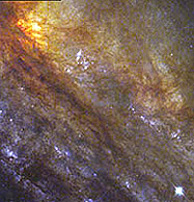
The HST Wide Field Camera has recently imaged a small cluster of stars in an
early stage of their organization. This is in the Small Magellanic Cloud, about
200,000 light years away. This "cloud" (almost 10 light years wide) consists
of glowing hydrogen gas within which numerous stars are embedded. At least 50
of those that can be resolved appear to be young, massive stars. As time continues,
these stars will enlarge as gravity pulls in the surrounding nebular material.
Because of their large size, their destiny is to rapidly burn up their hydrogen
fuel, and eventually exploding as supernovae (see below), many ending as neutron
stars.
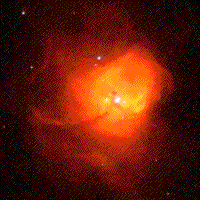
Gravitationally-driven collapse in a forming star induces compression and further heat rise. The protostar phase is reached as temperatures rise to 2000 - 3000 K. At ~10,000 ºK, the H begins to ionize (electrons stripped away) and, in the process, loses some heat energy by radiation which tends to slow or counter the compression. Thereafter, in the history of the star's life cycle there will be a continuous (somewhat oscillating) "contest" between contractive heating during stages of gravitational collapse and expansive cooling by thermal radiation outbursts whenever rising temperatures increase hydrogen ionization. Generally, an evolving star tends to seek out a balance [hydrostatic equilibrium] between inward gravitational forces and outward radiation pressure. In its early life, the contraction phase ultimately dominates, so that a star's deep interior temperature eventually will be raised above 107 K (varies with star size), at which stage a fundamental nuclear reaction within the hydrogen gas commences. This involves thermonuclear fusion: p + p => H2 + e+ + neutrinos (H2 [p + n] or deuterium and e+ is a positron [emitted]). That change of state results in thermal energy release which contributes to continual rises in temperature. As temperatures increase further, some protons, neutrons, deuterium (and minute amounts of tritium [H3]) combine (in a three step process) into helium (He4 nuclei [2p, 2n]) which migrate into the star's interior towards its core. Helium remains stable until temperatures approach 100 million K, at which state it reacts with more protons and neutrons to transmute into other elements of higher mass numbers (see below).
When the H => He process reaches a steady state, gravitational contraction no longer dominates (attains a balance), the star's total radiant (EM) energy output per second (defined as its luminosity) becomes constant, and the star reaches a stable state on the Main Sequence (M.S.), populated by stars that are primarily in the hydrogen-burning stages, in a plot of luminosity versus star surface temperature (which is expressed also by the star's visual color) known as the Hertzsprung-Russell Diagram.
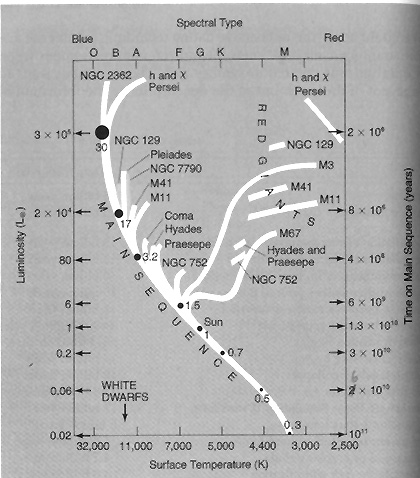
From J. Silk, The Big Bang, 2nd Ed., © 1989. Reproduced by
permission of W.H. Freeman Co., New York
As this diagram suggests, stars undergo evolutionary changes as they form and
then pass through their fuel burning cycle. They can be further categorized
in terms of their end products at completion of the burning; the type of star
that evolves depends on the initial mass of H gas as it reaches its early stage
of burning. Stars can also be classed according to their relative ages into
Population I and Population II types. Type I stars are generally
younger, and continue to form even today. In Spiral galaxies, they are most
common in the arms. Type II stars are older, having burned much of their fuel,
and generally reside near the galactic core in Spirals or are the dominant stars
in Elliptical galaxies. Type II's are deficient in heavier elements (which,
as shown later, are largely produced during late stages and explosive destruction
of earlier stars), which means that they developed in the younger Universe from
raw materials that had not yet accumulated these elements. Stars spend up to
90% of their total lives on the Main Sequence.
A star's precise position along the Main Sequence depends on the total mass
of H fuel that collects in the gas ball. Some stars have masses as low as 1/20th
of the Sun (1 solar mass is the standard of reference as is the luminosity of
the Sun, also set at 1), whereas others fall within a range of greater masses
that may exceed 50 solar masses. The high mass stars on the Main Sequence are
brighter and bluer whereas those at the lower end of the M.S. tend to be yellow
to orange. The initial quantity of mass in a star is the prime determinant of
its life expectancy, which also depends on its evolutionary history and final
fate. Stars with greater than 10 solar masses may complete their M.S. burning
in just 20-30 million years (Sun sizes and smaller take billions of years).
As a general rule, small stars may take hundreds of billions to burn out completely,
stars in the size range of the Sun live on the order of 5 to 15 billion years,
and much bigger stars carry their cycle to completion in a billion or less years.
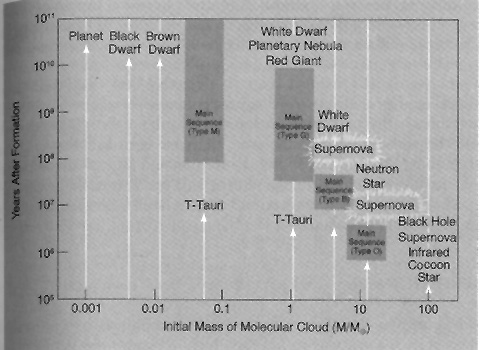
From J. Silk, The Big Bang, 2nd Ed., © 1989. Reproduced by
permission of W.H. Freeman Co., New York
Our Sun (a Population I Spectral Type G on the Main Sequence), like most stars
of similar or lower mass, began as a T-Tauri protostar which started
out as a distended cloud of dense dust and molecular gas that took 10 - 100
m.y. to contract into the hydrogen-burning stage. The Sun is a typical, or average,
star on the Main Sequence. Its size is approximately 1,392,000 km (865,000 miles)
in diameter (it is 130,000 times the volume of Earth). Temperatures in its central
core are estimated to reach about 15,000,000 K; at the solar surface (the photosphere)
the temperature has decreased to about 5500 °C. The next image, made by
the SOHO satellite launched in 1996, shows the surface, with its distinctive
convective patches known as granules and sunspots. Superimposed around this
image is a telephoto of the Sun's corona or outer atmosphere, a thin gaseous
envelope in which kinetic temperatures of fast-moving molecules range from 1,100,000
to 1,670,000 °C, taken during the solar eclipse of February 1998. Between
the corona and the photosphere is a gaseous atmosphere called the chromosphere
in which temperatures vary around 28,000 °C.
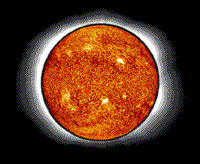
The Sun, now about 5 b.y. old, has a life expectancy of another 5 b.y. or so until it converts (following some arm up and to the right on the H-R diagram) first into a Red Giant (hot contracted core but cooler outer envelope of greatly expanded [up to 100x the normal star diameter] diffuse gases emitting surface radiation in the visible red). Red Giants develop as the hydrogen in the deep interior (core) is finally depleted and the helium derived from it tries to fuse (burn) to carbon. The core shrinks even as fusion continues in the outer regions of the star. Energy is rapidly lost, so that hydrostatic equilibrium is disturbed, allowing for expansion driven by stellar winds. The energy density of the star's surface, being lower, shifts emerging light wavelengths from bluish towards red. A Red Giant can exist up to 500,000 million years. Below is a typical Red Giant, as seen by the HST, present in the constellation Betelguese.
As the bulk of the mass is shed from the outer envelope of a giant whose initial mass was < 10 solar masses, it will lose nearly all its remaining nuclear fuel, shrinking rather abruptly (over a few thousand years) to a radius much less than Sun size (some as small as the Earth) and ending up as a dense, hot core (~1.4 solar masses) that becomes a very hot, but low luminosity White Dwarf. (surface temperatures as high as 170,000 K). White Dwarfs are, as the name suggests, small: A star the diameter of the Sun, shrinks to a size comparable to Earth but with a density of about 1,000,000 g/cubic cm. Its core mass is said to consist of degenerate matter, i.e., its pressure no longer depends on temperature owing to quantum effects, - in this case close-packed electrons are degenerate but not protons or neutrons. The White Dwarf nevertheless is still hot and bright. The ultimate fate of a Dwarf is to cool and fade away.
One or more rings or shells often represent the shedding of matter in the final ejection phase around a White Dwarf star. This stage is comparatively rapid, taking 10000 - 20000 years for the rings to disperse. These rings are also referred to as planetary nebulae (a misnomer in that planets are not the end product; the name refers to the torus- or disk-like appearance of these objects that resemble an early stage of a planet's formation). The scale of expansion places the edte of these gaseous envelopes at diameters around 1000 times that of our solar system.
The classic example is M57, the Ring Nebula, shown in thumbnail below, as seen by HST (red tones represent excited hydrogen; green is associated with ionized oxygen).
Two other HST images are instructive: beneath is NGC7027 (NGC refers to New General Catalog, a systematic listing of stars and galaxies observed through telescopes) in which the explosion of gases is in an early stage.
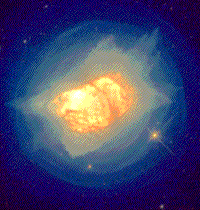
In the next image, the Cats-Eye nebula (NGC6543) appears to be a later stage of the outward propulsion of gases around a Red Giant (possibly one of a binary pair, with the second star a possible dwarf) in which several rings are made luminous through excitation by expelled particles.

The Hubble Space Telescope has now gathered hundreds of images showing "dying" stars, i.e., those in their last stages of fuel burning that are shedding matter explosively. The variety and complexity of a star's final activities has proved to be much more diverse than known from the era of conventional telescopic observations. A recent NASA press release documents work done by astronomers at the University of Washington and elsewhere that illustrates different observed end stages, shown in a panel of six images typifying this diversity of gaseous envelopes (these are typical planetary nebulae):
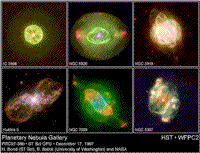
These brief descriptions define each observation: Top Left: A round planetary nebula with a bright inner shell and fainter outer envelope; this uniform expansion is the mode predicted for the final phase of the Sun's demise; Top Center: A hot remnant star surrounded by a green (color assigned) oval in which older gas is pushed ahead to form a bright interior rim; more gas further out shows hot spots (red); Top Right: A spherical outer envelope and an elongated inner "balloon" shell, both inflated by a fast wind from the interior star; Bottom Left: A "butterfly" or bipolar (two-lobed) nebula; Bottom Center: A bright central star at the center of a dark cavity bounded by a football-shaped rim of dense, blue and red gas; the star's former outer layers is shown in green; note long greenish jets; Bottom Right: A planetary nebula with a pinwheel or spiral structure with blobs of gas ejected from the central star.
The appearance of these planetary nebulae can be misleading. Orientation of a nebula relative to our vantage point from Earth, may present shapes thatare distorted from their reality. For example, a ring may actually be the edge-on view of a cylinder (looking down axis). Most planetary nebulae are non-spherical gas ejections showing usually axisymmetric morphology. We see this gas because it is excited (and thus glows) by ultraviolet radiation from the surviving White Dwarf as the Red Giant phase nears its end. The gas envelope shapes (jets, interlocking rings, "rectangles", etc.) are the consequence of strong stellar winds overtaking, at this stage, earlier, slower particle winds involved in Red Giant growth. The shapes assumed (such as the Butterfly type) indicate some degree of asymmetric wind release. Another factor is the likelihood of these nebulae being influenced or associatd with companion binary stars (or a star and a large orbiting planet).
Stars too massive to end up as White Dwarfs become non-luminous Neutron stars (with such strong internal pressures that neutrons are formed by intense squeezing together of protons and electrons) instead, ending up with small cores (about 4-5 solar masses) only a few kilometers wide whose densities can exceed 1014 gm/cc (or 107 denser than White Dwarfs). Some Neutron stars, called Pulsars, are known to have intense magnetic fields and to emit directional beams of radio pulses in regular intervals (with periods from about 1/1000th of a second to several seconds) whose cyclical nature is related to their (often rapid) rotation; the Earth must lie within the beam's solid angle in order to detect this Pulsar action (the pulses therefore are bursts of radiation from a constant beam detected intermittently from Earth, much like a searchlight's beam, while sweeping continuously, appears to the viewer only when aligned momentarily as it passes through its cycle). Pulsars are formed by the neutron star's immense gravity pulling gas from its companion star, such that this gas is accelerated to a third of the speed of light or more and "detonates" when it strikes the neutron star surface releasing great quantities of energy including thousands of bursts of x-rays that rise from the surface in pods or columns many times each second giving rise to a periodicity.
Massive stars, originally with 8 to 50+ solar masses,
burn their gaseous fuel (in the plasma state [atoms
are ionized]) much more rapidly until nuclear processes
force the gases away at high velocities from the core
in an explosion whose early stage may be seen from
Earth for a few years as a hugely luminous event called
a supernova. Supernovae occur, on average,
about once every 30-50 years in a galaxy (a nova,
which is a bright flare up of a star without its being
destroyed explosively, is much more common). (In December,
1997, astronomers observed a localized event in deep
space which released more gamma ray energy at that
point than has been calculated to emanate from the
entire Universe under a normal state; this huge generation
has been dubbed a "hypernova".) The initial flare-up
may take only a few seconds to actuate but the effects
can last for weeks to months. Supernovae in our galaxy
and others nearby can appear as very bright light
sources visible to the naked eye. A prime example
is this Palomar telescope view of the Crab Nebula
(left), with an HST Wide Field Camera view of the
volume within the square shown on the right ).
The Crab Nebula is famous in history. It was first observed in 1054 A.D. by Chinese astronomers as a suddenly appearing bright light, seemingly within the Taurus constellation, remained intense enough so that for a few years it could be seen even during the day. Modern telescope views show that filaments are streaming from the explosion center as speeds up to half that of light. This supernova is, like others in general, an extremely energetic event, radiating from short wavelengths (gamma rays) through the visible and into the long wave radio region. A pulsar-neutron star, rotating 30 times a second, has been detected in its central region.
Another example is Eta Carinae, in which a combination of red and UV filter images from HST shows an apparent "cloud" of matter which is actually mainly a light burst from this supernova, now some 10 billion miles across, that resulted from the explosion of a star 100x more massive than our Sun.
In February, 1987 the brightest supernova in nearly 500 years, SN1987A (located
in the Large Magellanic Cloud), was discovered in the southern hemisphere skies
from an Observatory in Chile. Since then, it is being continuously monitored
both from Earth and from the HST, providing a "stellar" example of
the self-destruction of a star by catastrophic explosion. The event began about
167,000 years ago, based on distance measurements. In its last moments, the
star first cast off an envelope of gases as it expanded to a Red Giant, evolving
rapidly into a Blue Giant. As its core collapsed, it finally exploded violently
in seconds, pushing away exterior gases driven by shock waves, and releasing
a huge burst of neutrinos as the core protons and electrons were squeezed into
neutrons. Visual changes within the star and its surroundings have since been
observed in just a decade; thus:
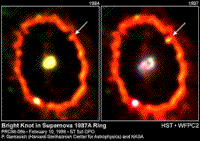
In the left image made by HST in 1994, the blast has pushed out a ring of incandescent gases whose diameter is about 162 million km (100 million miles). The bright central star still appears largely intact. As witnessed again in February 1998, the central star has changed notably, with broad structural variations marking disruption progress. The arrows pointing to an area in the upper right indicated growth of a "hot spot" (yellow) caused by further compression of the gases in the ring. This supernova is also expressive as a concentrated source of x-ray, UV radiation, and radio waves.
A somewhat different mode of destruction of a massive star involves violent, chaotic expansion of red-glowing (in the visible) gases from a star type known as a Wolf-Rayet star,as shown below, here seen in an early stage of expansion around the still intact central Giant (about 40-50 solar masses).
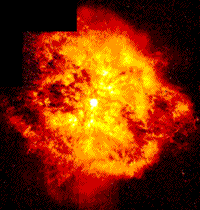
As seen in the star evolution diagram above, when gases and other matter of
50 or greater solar masses gravitationally contract into small, compact bodies,
the result is a Black Hole, so called because the gravity associated
with its extremely dense mass can prevent all detectable radiation from escaping
beyond its event horizon (sphere of influence), also known as the Schwartzchild
radius. Since it is invisible (black), its existence can only be inferred from
its gravitational effect on surrounding stars and interstellar matter. Black
Holes were predicated to exist from General Relativity considerations. However,
time itself does not have a meaningful status within a B.H. A Black Hole generally
is so small that its space-time expression produces a curvature so pronounced
that all internal energy (radiation) is seemingly trapped within the horizon.
An exception may be Hawking radiation (named after Stephen Hawking who devised
the theory) consisting of virtual particles (mainly photons) created by quantum
processes driven by the gravitational energy within the Hole; this radiation
is associated with only tiny Black Holes and provides a means by which they
can dissipate over extremely long times through "evaporation".
A Black Hole's incredible gravity pulls in particles from outside the event
horizon until their velocities are accelerated near the speed of light. Matter
is literally torn apart upon entering the Black Hole. As these particles close
in, monstrous energy releases produce continuous bursts of energy outside the
horizon, a process believed responsible for most Quasars (a contractive
term for "quasi-stellar" to describe a star-like appearance even though
the observed feature is not a single star). Quasars are extremely bright objects
(very high luminosity), being perhaps the glow of radiation bursts ("hot spots"
of gamma radiation and x-rays) from matter infalling into nuclei of active galaxies
(probably supermassive Black Holes). Most are so far away that light arriving
at Earth left them when the young Universe was only about 1/4 to 1/6 its present
size. Thus, most quasars formed early in Universe history and, particularly
the larger ones, have since become "dormant" (with occasional flare-ups),
i.e., are greatly diminished to extinguished in today's time frame. But Black
Holes can still form in young cosmological time throughout the Universe, conceivably
giving rise (usually after only millions of years) to new quasars. Quasars are
made visible because of emission of light resulting from energy conversion as
stars and interstellar gases are gravitationally sucked into supermassive Black
Holes. HST has observed such events, as shown in this image of the elliptical
galaxy NGC4261, in which the ring seemingly surrounds such a hole.
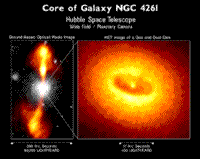
Below is a more recent enhanced image of the Black Hole region at the center of NGC4261, emphasizing the toroidal character of the glowing dust and gas (which may be the remnants of a small galaxy being "devoured" as it is drawn into the B.H. This donut-shaped disc is only about 800 light years wide.
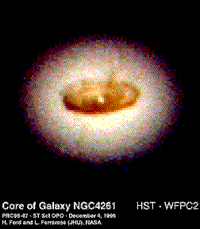
Black Holes can vary in dimensions, the smallest in the general class being much less than a kilometer in diameter but packing mass equivalent to about 3 solar masses. Humongous B.H.s can contain masses derived from billions of infalling stars and galactic matter, attaining sizes exceeding that of our Solar System. Massive Black Holes may be the customary state at the center of spiral and other galaxy types, having built up from millions stars and other matter converging inward as though moving to a drain. The HST view of NGC7742, a Seyfert type 2 active galaxy, shows a large glowing central region, within which a supermassive Black Hole is postulated. Its bright center probably represents a quiescent quasar state, resulting from energy release when stars spiral past the B.H. horizon into its interior; note the ring of bright hot, largely younger stars beyond and the faint spiral arms further out.
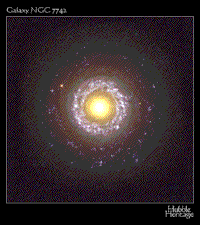
Some Black Holes are thought to be the sole surviving remnants of galaxies that have been completely swept into them. Other Black Holes may have formed during the first seconds of the Big Bang. In some respects, Black Holes are an approximation to the supersingularity postulated as the starting point of the Big Bang except that they have finite dimensions of meters to several kilometers and even much larger for those in galactic centers depending on their amounts of mass (can be equivalent to the cumulate mass of hundreds of millions to billions of Suns). One theoretical class of Black Holes represent extreme densities concentrated in "points" as small as 10-15 meters. Speculatively, one future outcome for the Universe (depending on the ultimate mode of expansion [see page Cosmo-5]) , after 50 b.y. or so, could be a collection of billions of Black Holes that eventually converge upon themselves to coalesce into a single ultra-dense Black Hole that ultimately would become the singularity for the next Universe (in this model, any number of successive Universes, exploding and contracting cyclically, is feasible). Such a concept of repeating Universes (treated in more detail on page Cosmo-6) is referred to as the "Big Crunch", or even more colloquially, as the "Bounce" in reference to the repetition of an explosion after total collapse to the B.H. singularity.
Stars, particularly the massive ones, are the furnaces in which the elements beyond H, He, and some Li are created (stellar nucleosynthesis) by successive steps in nuclear fusion in which more and more protons and neutrons are joined into stable to unstable nuclei. A typical, but somewhat generalized sequence of nucleosynthesis is depicted in the figure below for a star composed initially of 20 solar masses (MO) of hydrogen, but now in its final stage of evolution in which the star consists a sequence of elements formed progressively with depth as it heated up and contracted. The relative proportions of each element are given by the numbers in each shell. Stars with greater than 10 solar masses will proceed to the iron core stage; a Sun-sized star reaches only the carbon core stage.
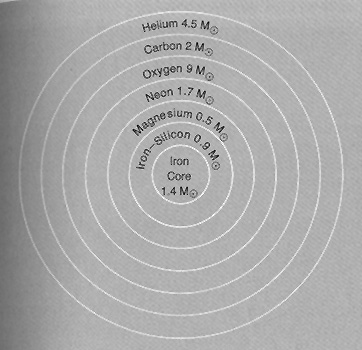
From J. Silk, The Big Bang, 2nd Ed., © 1989. Reproduced by permission
of W.H. Freeman Co., New York
As a massive hydrogen-rich star contracts and experiences greater pressures,
helium is the first nuclear product within its core region. The energy released
from fusion, along with continuing densification, yields higher temperatures
(1-2 x 108 K) that transmute this innermost helium into carbon (by
fusion of three helium nuclei) while producing new helium at the next outer
shell, but with hydrogen still dominant. Once carbon is formed in abundance,
this helium is generated as an end product of the CNO cycle. In this, some C12
reacts with protons to generate, in successive steps, nitrogen 13, 14, and 15
and then oxygen 15. After this last step, that unstable oxygen isotope can decay
by fission, thereby releasing an alpha particle (He4, stripped of
its electrons) causing the reversion to C12.
Ever greater contraction, with concomitant temperatures reaching > 5 x 108
K for elements like sodium and magnesium, 1 x 109 K for oxygen, and
approaching 3 x 109K for nickel, cobalt, and iron, can progressively
generate the elements listed in the figure up to iron (plus others of lesser
atomic numbers) in amounts proportional to the comparative solar masses indicated.
Thus, a star massive enough to ultimately achieve an iron core also contains
elements of lower atomic numbers in its outer shells, broadly distributed in
the relative positions shown in the figure, reflecting response to the fuel
to outwardly decreasing densities and temperatures. Iron (atomic number Z [no.
of protons]= 26; mass number A [number of protons + neutrons] = 56) is the heaviest
element producible directly by stellar fusion. In fusion, nuclear binding energies
for the new nuclides increase gradually up to iron but the mass of a fused nuclide
is less than the sum of the fusing constituents. The missing mass is converted
to energetic particles (E = mc2), given off as gamma rays, neutrinos,
positrons, and others; thus the fusion process is always an energy-releasing
one.
Elements with A greater than Fe have decreasing binding energy and to form
require energy input from non-fusion processes (principally neutron capture).
Because those stars capable of synthesizing elements up to Fe have masses greater
than 10 solar masses, these stars at their end stage of fusion will rapidly
(over spans of hundreds of years) collapse and explode (fly apart) as novae
or supernovae. This gives rise to intense neutron fluxes that manufacture
various elements including those with A > 56 , most of which become rapidly
dispersed into interstellar space. These heavier elements, along with H, He
and the A < 56 elements (which include O, S, C, N, Fe, Mg, Ca, Al, Na, and
K - the dominant constituents making up the planets), can thereafter collect
into new nebulae (clouds) that may reorganize into additional stars, setting
up further nucleosynthesis. The elements were mostly created in the first few
billion years when rates of star formation, burning, and explosive destruction
were higher than present, but the process of element production still goes on.
Elemental materials not reincorporated in stars are available to organize into
compounds that make up the dust, gases, and particles from which planetary bodies
are assembled.

Collaborators: Code 935
NASA GSFC, GST, USAF
Academy
Contributor Information
Last Updated: September '99
Webmaster: Bill Dickinson Jr.
Site Curator: Nannette Fekete
Please direct any comments to rstweb@gst.com.